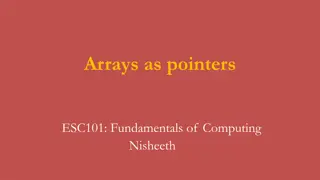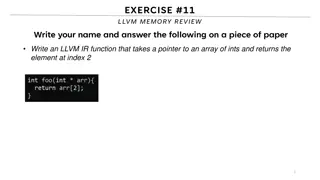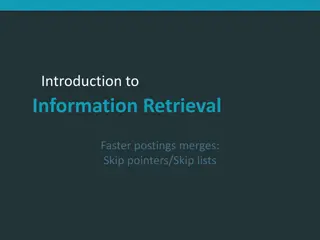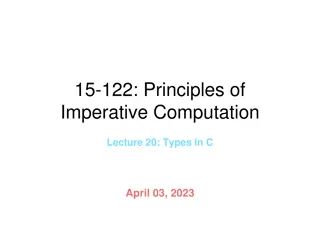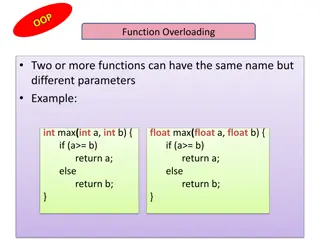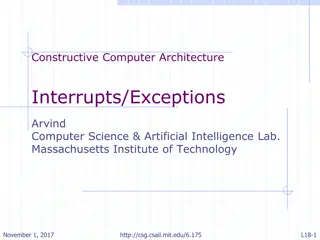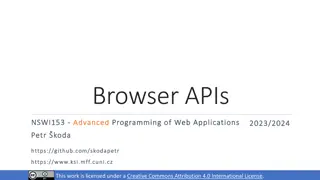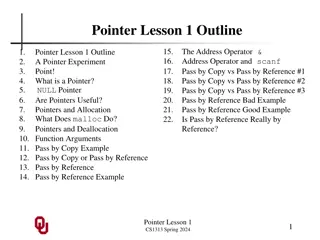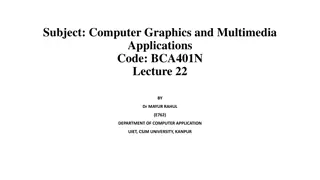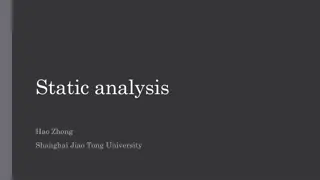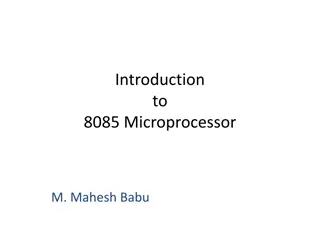Pointer Analysis
This research by G. Ramalingam and K. V. Raghavan from Microsoft Research, India, delves into the intricate world of pointer analysis. The study offers valuable insights and findings regarding this important topic, contributing to the ongoing discourse in the field.
Download Presentation

Please find below an Image/Link to download the presentation.
The content on the website is provided AS IS for your information and personal use only. It may not be sold, licensed, or shared on other websites without obtaining consent from the author.If you encounter any issues during the download, it is possible that the publisher has removed the file from their server.
You are allowed to download the files provided on this website for personal or commercial use, subject to the condition that they are used lawfully. All files are the property of their respective owners.
The content on the website is provided AS IS for your information and personal use only. It may not be sold, licensed, or shared on other websites without obtaining consent from the author.
E N D
Presentation Transcript
Pointer Analysis G. Ramalingam Microsoft Research, India & K. V. Raghavan
Goals Points-to Analysis: Determine the set of possible values of a pointer-variable (at different points in a program) what locations can a pointer point-to? Alias Analysis: Determine if two pointer- variables may point to the same location Compute conservative approximation A fundamental analysis, required by most other static analyses
A Constant Propagation Example x = 3; x is always 3 here can replace x by 3 and replace x+5 by 8 and so on y = 4; z = x + 5;
A Constant Propagation Example With Pointers x = 3; Is x always 3 here? *p = 4; z = x + 5;
A Constant Propagation Example With Pointers if (?) p = &x; else p = &y; x = 3; *p = 4; z = x + 5; most program analyses p = &y; x = 3; *p = 4; z = x + 5; p = &x; x = 3; *p = 4; z = x + 5; x is always 3 pointers affect x is always 4 x may be 3 or 4 (i.e., x is unknown in our lattice)
A Constant Propagation Example With Pointers if (?) p = &x; else p = &y; x = 3; *p = 4; z = x + 5; p = &y; x = 3; *p = 4; z = x + 5; p = &x; x = 3; *p = 4; z = x + 5; p always points-to y p always points-to x p may point-to x or y
Points-to Analysis Determine the set of targets a pointer variable could point-to (at different points in the program) p points-to x p stores the value &x *p denotes the location x targets could be variables or locations in the heap (dynamic memory allocation) p = &x; p = new Foo(); or p = malloc ( );
Algorithm A (may points-to analysis) A Simple Example p = &x; q = &y; if (?) { q = p; } x = &a; y = &b; z = *q;
Algorithm A (may points-to analysis) A Simple Example p p p p p p p p p p q q q q q q q q q q x x x x x x x x x x y y y y y y y y y y z z z z z z z z z z null null null null null null null null null null null null null null null null null null null null null null null null null null null null null null null null null null null null null null null null null null null null null p = &x; q = &y; if (?) { q = p; } x = &a; y = &b; z = *q; x x x x x x x x null null null null null null null null null null null null null null null null null null null null null null null null null null null null null null null null x x x x x x x y y y y y y y null null null null null null null null null null null null null null null null null null null null null x x x x x x y y y y y y null null null null null null null null null null null null null null null null null null x x x x x x x x x x null null null null null null null null null null null null null null null x x x x {x,y} {x,y} {x,y} {x,y} null null null null null null null null null null null null x x x {x,y} {x,y} {x,y} a a a null null null null null null x x {x,y} {x,y} a a b b null null x {x,y} a b {a,b}
Algorithm A (may points-to analysis) A Simple Example x = &a; y = &b; if (?) { p = &x; } else { p = &y; } x: a y: b How should we handle this statement? (Try it!) Weak update Weak update Strong update p: {x,y} a: null *x = &c; *p = &c; x: a y: b p: {x,y} a: c x: {a,c} y: {b,c} p: {x,y} a: c
Questions When is it correct to use a strong update? A weak update? Is this points-to analysis precise? We must formally define what we want to compute before we can answer many such questions
Points-To Analysis: An Informal Definition Let u denote a program-point Define IdealMayPT (u) to be a function \p. {x | p points-to x in some state at u in some run } Algorithm should compute a function MayPT(u) that over-approximates above function
Static Program Analysis A static program analysis computes approximate information about the runtime behavior of a given program 1. The set of valid programs is defined by the programming language syntax 2. The runtime behavior of a given program is defined by the programming language semantics 3. The analysis problem defines what information is desired 4. The analysis algorithm determines what approximation to make
Programming Language: Syntax A program consists of a set of variables Var a directed graph (V,E,entry) with a distinguished entry vertex, with every edge labelled by a primitive statement A primitive statement is of the form x = null x = y x = *y x = &y; *x = y skip (where x and y are variables in Var) Omitted (for now) Dynamic memory allocation Pointer arithmetic Structures and fields Procedures
Example Program 1 Vars = {x,y,p,a,b,c} x = &a; y = &b; if (?) { p = &x; } else { p = &y; } x = &a 2 y = &b 3 p = &x p = &y 4 5 skip skip 6 *x = &c 7 *x = &c; *p = &c; *p = &c 8
Programming Language: Operational Semantics Operational semantics == an interpreter (defined mathematically) State DataState ::= Var -> (Var U {null}) Initial-state: \x. null
Example States Vars = {x,y,p,a,b,c} Initial data-state 1 x: N, y:N, p:N, a:N, b:N, c:N x = &a 2 Initial program-state x: N, y:N, p:N, a:N, b:N, c:N <1, > y = &b 3 p = &x p = &y Next program-state x: a, y:N, p:N, a:N, b:N, c:N <2, > 4 5 skip skip 6 *x = &c 7 *p = &c 8
Programming Language: Operational Semantics Meaning of primitive statements CS[stmt] : DataState -> 2DataState CS[ x = null ] s = {s[x null]} CS[ x = &y ] s = {s[x y]} CS[ x = y ] s = {s[x s(y)]} CS[ x = *y ] s = CS[*x = y ] s = =
Programming Language: Operational Semantics Meaning of primitive statements CS[stmt] : DataState -> 2DataState CS[ x = null ] s = {s[x null]} CS[ x = &y ] s = {s[x y]} CS[ x = y ] s = {s[x s(y)]} CS[ x = *y ] s = {s[x s(s(y))]}, = {}, otherwise CS[*x = y ] s = if s(y) is not null
Programming Language: Operational Semantics Meaning of primitive statements CS[stmt] : DataState -> 2DataState CS[ x = null ] s = {s[x null]} CS[ x = &y ] s = {s[x y]} CS[ x = y ] s = {s[x s(y)]} CS[ x = *y ] s = {s[x s(s(y))]}, = {}, otherwise CS[*x = y ] s = {s[s(x) s(y)]}, if s(y) is not null = {}, otherwise if s(x) is not null
Programming Language: Operational Semantics Let u denote a vertex in the CFG Define RS(u) = { s | s is a DataState that can arise at point u in some execution } It is the collecting semantics at u
May-Point-To Analysis: Problem statement Compute MayPT: V -> 2Var such that for every vertex u MayPT(u) IdealMayPT(u), where Var = Var U {null}. Given two functions f and g, we say f g, iff forall x f(x) g(x)
May-Point-To Algorithms Compute MayPT: V -> 2Vars such that MayPT(u) IdealMayPT(u) An algorithm is said to be correct if the solution MayPT it computes satisfies u V. MayPT(u) IdealMayPT(u) An algorithm is said to be precise if the solution MayPT it computes satisfies u V. MayPT(u)=IdealMayPT(u) An algorithm that computes a solution MayPT1 is said to be more precise than one that computes a solution MayPT2 if u V. MayPT1(u) MayPT2(u)
Algorithm A: A Formal Definition The Data Flow Analysis Recipe Define semi-lattice of abstract-values AbsDataState ::= (Var -> (2Var {})) {bot} f1 f2 = \x. (f1 (x) f2 (x)) Define initial abstract-value InitialAbsState = \x. {null} Define transformers for primitive statements AS[stmt] : AbsDataState -> AbsDataState
Algorithm A: A Formal Definition The Data Flow Analysis Recipe Apply Kildall s algorithm, using AbsDataState lattice, and AS transfer functions.
Algorithm A: The Transformers Abstract transformers for primitive statements AS[stmt] : AbsDataState -> AbsDataState AS[ x = y ] s = s[x s(y)] AS[ x = null ] s = s[x {null}] AS[ x = &y ] s = s[x {y}] AS[ x = *y ] s = s[x s*(s(y)-{null})], if s(y) is not = {null} = bot, otherwise where s*({v1, ,vn}) = s(v1) s(vn),
Algorithm A AS[ *x = y ] s = bot if s(x) = {null} s[z s(y)] if s(x)-{null} = {z} s[z1 s(z1) s(y)] if s(x)-{null} = {z1, , zk} [z2 s(z2) s(y)] (where k > 1) [zk s(zk) s(y)] After fix-point solution is obtained, AbsDataState(u) is emitted as MayPT(u), for each program point u
An alternative algorithm: must points-to analysis AbsDataState is modified, as follows: Each var is mapped to {} or to a singleton set join is point-wise intersection Let MustPT(u) be fix-point at u Guarantee: (MustPT(u)) MayPT(u) IdealMayPT(u) where (S) = S, if S is a singleton set = Var , if S = {}
Must points-to analysis algorithm AS transfer functions same as in Algorithm A for x = y, x = null, and x = &y AS[ x = *y ] s = bot, if s(y) = {null} = s[x {}], if s(y) = {} = s[x s(z)], if s(y) = {z}
Must points-to analysis algorithm AS[ *x = y ] s = bot, if s(x) = {null} = s[z s(y)] if s(x) = {z} = \v. {}, otherwise This analysis is less precise than the may-points-to analysis (Algorithm A), but is more efficient



